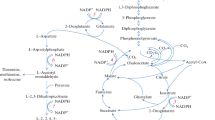Abstract
When transformed with a recombinant vector carrying the ubiC gene (encoding chorismate pyruvate-lyase, EC 4.1.3.27) the triple mutant (Phe−, Trp−, Tyr−) Klebsiella pneumoniae 62-1 excretes 4-hydroxybenzoic acid instead of chorismic acid. The recombinant strain can be used to produce in high yield specifically ring-labelled 4-hydroxybenzoic acid from isotopically labelled glucose.
Similar content being viewed by others
References
Baldwin JE, Bausal HS, Chondrogianni J, Gallagher PT, Taha AA, Taylor A, Thaller V (1984) Synthesis of [15N]−, [1−13C]−, [3−13C]−, [ring−1, 2−13C2]−, and [ring-3, 4, 5−13C3]−, labelled DL-tyrosine. J Chem Res (Synop) 176−177
Bullock WO, Fernandez JM, Short JM (1987) XL1-Blue: a high efficiency plasmid transforming recA Escherichia coli strain with beta galactosidase selection. Biotechniques 5:376–378
Floss HG, Keller PJ, Beale JM (1986) Studies on the biosynthesis of antibiotics. J Nat Prod 49:957–970
Gibson J, Dispensa M, Fogg GC, Evans DT, Harwood CS (1994) 4-Hydroxybenzoate-coenzyme A ligase from Rhodopseudomonas palustris: purification, gene sequence, and role in anaerobic degradation. J Bacteriol 176:634–641
Haslam E (1993) Shikimic acid-metabolism and metabolites. Wiley, Chichester
Heide L, Tabata M (1987) Geranylpyrophosphate: p-hydroxybenzoate geranyltransferase activity in extracts of Lithospermum erythrorhizon cell cultures. Phytochemistry 26:1651–1655
Inouye H, Leistner E (1988) vol. Biochemistry of quinones. In: Patai S., Rappoport Z (eds) The chemistry of quinonoid compounds, vol 2. Wiley, Chichester, pp 1294–1344
Jurkova M, Wurst M (1993) Biodegradation of aromatic carboxylic acids by Pseudomonas mira. FEMS Microbiol Lett 11:245–250
Kaneda T, Obata H, Tokumoto M (1993) Aromatization of 4-oxocylohexanecarboxylic acid to 4-hydroxybenzoic acid by two distinctive desaturases from Corynebacterium cyclohexanicum. Properties of two desaturases. Eur J Biochem 218:997–1003
Löscher R, Heide L (1994) Biosynthesis of 4-hydroxybenzoate from p-coumarate and p-coumaroyl-coenzyme A in cell-free extracts of Lithospermum erythrorhizon cell cultures. Plant Physiol 106:271–279
Niemann GJ (1995) A crucial role of phenolic metabolism in resistance of carnations to wilt diseases. Acta Hort (in press)
Nieβner N, Mühlebach A, Lyerla JR (1993) Synthesis of isotopically labelled monomers and polymers of 4-hydroxybenzoic acid and 6-hydroxy-2-naphthoic acid. Makromol Chem 194:649–663
Nishimura A, Morita M, Nishimura Y, Sugino Y (1991) A rapid and highly efficient method for preparation of competent Escherichia coli cells. Nucleic Acids Res 18:6169
Rajagopalan JS, Jaffe EK (1993) Microbial production and NMR characterization of [2, 6, 9−13C] chorismate and [1, 3, 5, 8−13C] chorismate. Bioorg Med Chem Lett 3:1453–1456
Rusche J, Flanders PH (1985) Hexamin cobalt chloride promotors intermolecular ligation of blunt end DNA fragments by T4 DNA ligase. Nucleic Acids Res 13:1997–2008
Schmid HV, Zenk MH (1971) p-hydroxybenzoic acid and mevalonic acid as precursors of the plant naphthoquinone alkannin. Tetrahedron Lett 44:4151–4155
Schmidt K, Leistner E (1995) Microbial production of (+)-trans-isochorismic acid. Biotechnol Bioeng 45:285–291
Siebert M, Bechthold A, Melzer M, May U, Berger U, Schröder G, Schröder J, Serverin K, Heide L (1992) Ubiquinone biosynthesis. Cloning of the genes for chorismate pyruvate-lyase and 4-hydroxybenzoate octaprenyl transferase from Escherichia coli. FEBS Lett 307:347–350
Siebert M, Severin K, Heide L (1994) Formation of 4-hydroxybenzoate in Escherichia coli: characterization of the ubiC gene and its encoded enzyme chorismate pyruvate-lyase, Microbiology 140:897–904
Spratt BG, Hedge PJ, te Heesen S, Edelman A, Broome-Smith JK (1986) Kanamycin resistant vectors that are analogous of plasmids pUC8, pUC9, pEMBL8 and pEMBL9. Gene 41:337–342
Vogel HJ, Bonner DM (1956) Acetylornithase of Escherichia coli: partial purification and some properties. J Biol Chem 218:97–106
Zenk MH (1964) Einbau von p-Hydroxybenzoesäure in die Hydrochinonkomponente des Arbutins in Bergenia crassifolia. Z Naturforsch [B] 19:856–857
Author information
Authors and Affiliations
Rights and permissions
About this article
Cite this article
Müller, R., Wagener, A., Schmidt, K. et al. Microbial production of specifically ring-13C-labelled 4-hydroxybenzoic acid. Appl Microbiol Biotechnol 43, 985–988 (1995). https://doi.org/10.1007/BF00166913
Received:
Revised:
Accepted:
Issue Date:
DOI: https://doi.org/10.1007/BF00166913



